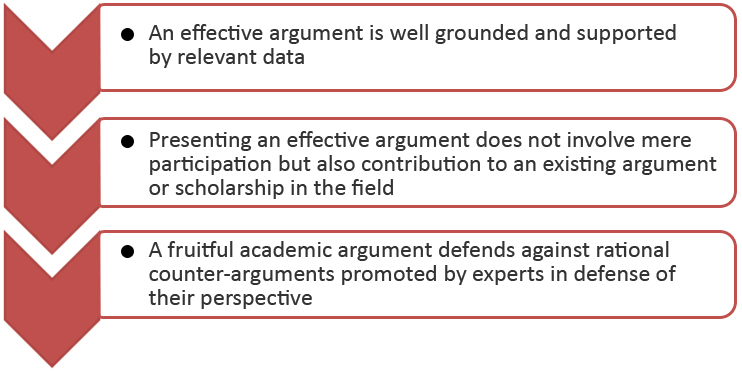Developing an Argument in Academic Writing

The word argument is derived from the Latin word “arguer,” which means “to make clear.” An essential aspect of academic writing is arguing and discussing. This involves proposing a claim and offering a rational reason with help of evidence that strengthens an author’s point of view. When presenting an argument, the possible counter-arguments should be taken into account. Thus, an academic argument can be called as an evidence-based defense of a complex issue.
Features of an Effective Argument

Consider the following quotation by Kenneth Burke (1941),
Imagine that you enter a parlor. You come late. When you arrive, others have long preceded you, and they are engaged in a heated discussion, a discussion too heated for them to pause and tell you exactly what it is about. In fact, the discussion had already begun long before any of them got there, so that no one present is qualified to retrace for you all the steps that had gone before. You listen for a while, until you decide that you have caught the tenor of the argument; then you put in your oar.
Thus, it can be concluded that presenting an argument involves an understanding of the reasoning being presented (the context) as well as ensuring that intervention (i.e., presenting the argument) takes place when there is something significant to contribute.
To evaluate or present arguments in a structured manner, the following questions can be considered:
- Identifying the claim or point of view
- Reasons for supporting that claim
- Whether this belief of the claim is built on reliable evidence
- Ensuring a coherent connection between the reasons for supporting the claim
- Preparing a convincing and persuasive defense for counter-arguments
Two Broad Approaches are Generally Employed when Presenting an Argument
The Balanced View
In a balanced view, the argument is introduced to the reader with commentary on its relevance and contribution to the field. Next, reasons for and against the argument are presented with conclusive and convincing evidence. In the end, after summarizing and considering a holistic and rational view of the argument, the author can present his own views with reasons and evidences supporting his claims.
The Persuasive View
The persuasive view involves a brief presentation of the argument and an immediate revelation of the author’s perspective. Along with this, the author also reveals what they aim to prove in the manuscript. Next, reasons against the introduced argument are provided to the readers based on the evidence gathered. Counter-arguments are then presented in favor of the author’s claim or perspective, leading up to a conclusive stance that convinces the reader to consider the author’s point of view. In such argument structures, it is important to ensure that a degree of certainty dominates the manuscript (as opposed to the balanced view, which may often employ hedging).
Therefore, before writing an article or manuscript, it is important to find a focus that will drive your research. In essence, your research should revolve around and objectively consider this focus before taking a stance. Most assuredly, it is important to explore and decide your position before proceeding with the actual writing.
References:
Using English for Academic Purposes. Rhetorical functions in academic writing: Arguing and discussing. Retrieved from http://www.uefap.com/writing/function/argue.htm
Dennis G. Jerz (2014, August 1) Academic Argument: Evidence-based Defense of a Non-obvious Position. Retrieved from http://jerz.setonhill.edu/writing/academic1/academic-argument-evidence-based-defense-of-a-non-obvious-position/
Duke University Writing Studio. Making an Argument. Retrieved from uwp.duke.edu/uploads/assets/Making%20an%20Argument%20Presentation.ppt










Ur information really helped me…
Good to know that this Enago Academy article helped you. Please feel free to share our posts with your network. Make sure you subscribe to our weekly newsletter (https://www.enago.com/academy/subscribe-now/). Have a nice day!
Good to know that Enago Academy could be of help to you. Make sure you subscribe to our weekly newsletter (https://www.enago.com/academy/subscribe-now/). Please feel free to share our posts with your network. Have a great day!
This piece has been helpful to me. I hope others discover it too.